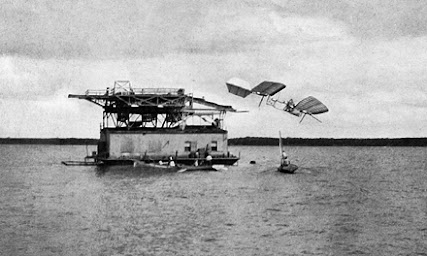Langley's flying machine was unpiloted and called an aerodrome. He was known for his work as an astronomer and was the secretary of the Smithsonian. The Wright's lacked college degrees and only had income from their bike shop to fund their experiments in building a man-controlled flying machine. In contrast, Langley received $50,000 from the U.S. War Department and $20,000 from the Smithsonian to fund his experiments after he had success with his models. The funding came with the expectation of having a piloted flying machine for military purposes.
 |
| Samuel Pierpont Langley's aerodrome experiment over the Potomac River, 1903. |
In 1903 Langley made two attempts at manned flight. The first attempt was on Oct. 7 and the second on Dec. 8. Both attempts crashed into the Potomac River on takeoff. Had the aerodrome made it into the air, the 'pilot,' if you can call him that, had zero control over the flight, and there was no landing gear. Nine days later, on Dec. 17, 1903, the Wright brothers made and documented the first successful piloted flight in history.
 |
| Wright Type A Airplane. Orville Wright at Ft. Myer, VA Sept. 09, 1908. |
Eight years later, William Benjamin Wright, Jr., enlisted in the Army Air Force, then known as the Aviation Corps, a branch of the Signal Corps. Though he's not related to the Wright brothers, he shared their dreams of aviation. As a pioneer pilot, he made aviation history while in France during World War I. He is credited as the first American to perform aerial reconnaissance to adjust artillery
fire on the battlefront. This technique has proved vastly useful in both world wars and is still being used. He performed these missions from both an airplane and a balloon.
 |
| Capt. Wright, Jr. on his motorcycle in front of his lucky No. 5 airplane "Krazy Kat Escadrille," France 1918. |
 |
| Col. William B. Wright, Jr., 1945. Barksdale AFB 7th Commander 1942-1945. |
In an article appearing in "The Barksdale Bark," announcing his reassignment, the writer points out, "It is significant that the pioneer aviator, who rode the tail of a Caudron J-4 down in a crash near Tours, France, in 1918, without injury, was to later inaugurate the training of combat crews at Barksdale in the mighty Superforts, which, as he says, 'roar clear across Louisiana in a takeoff.' He has helped develop air power from its infancy to the tremendous striking power it now possesses."
While at Barksdale, he was noted for his "gigantic" expansion program. He expanded the recreational facilities by installing boxing rings, an EM golf course, picnic grounds on Flagg Lake, bowling alleys, ball diamonds, and the Non-Commissioned Officers Club.
To learn more about the history of Barksdale AFB or aviation history in Bossier Parish, visit the Bossier Parish Libraries History Center. Your leading source for Bossier Parish History. We are at 2206 Beckett Street, Bossier City. Can't come in, call 318-746-7717 or email history-center@bossierlibrary.org with your request. Follow us @BPLHistoryCenter on FB, @bplhistorycenter on Tiktok, and check out our blog, http://bpl-hc.blogspot.com/.
Dear Amy Robertson,
ReplyDeleteI came across your blog post about Pioneer Pilot Makes Military Aviation History, and I just wanted to take a moment to thank you for sharing such valuable insights. As someone who is interested in the automotive industry, I found your article to be both informative and engaging.
It's clear that you have a deep understanding of the different types of automotive machine shop equipment and how they are used. Your explanations were clear and easy to follow, and I appreciated the attention to detail you provided. I especially enjoyed learning about the various benefits that this equipment can provide to businesses in the industry.
Thank you again for taking the time to write this article. Your expertise and knowledge are truly appreciated. I look forward to reading more of your work in the future.